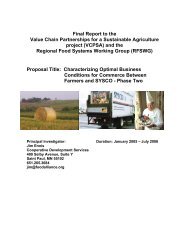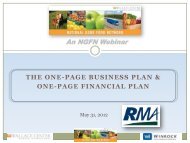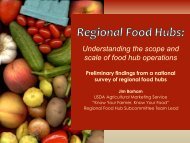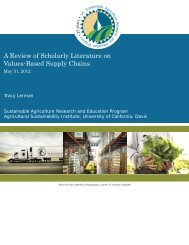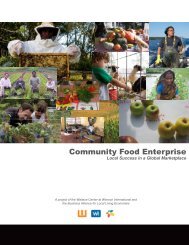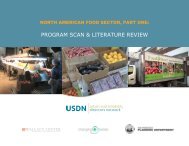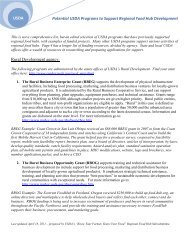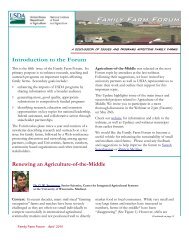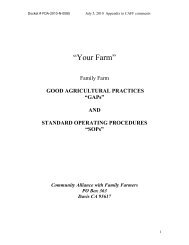The Common Market Feasibility Study - Agricultural Marketing Service
The Common Market Feasibility Study - Agricultural Marketing Service
The Common Market Feasibility Study - Agricultural Marketing Service
You also want an ePaper? Increase the reach of your titles
YUMPU automatically turns print PDFs into web optimized ePapers that Google loves.
THE COMMON MARKET FEASIBILTY STUDYSupply Analysis44confront in trying new approaches to sales (e.g., changing from direct retail to wholesale). Althoughmost of the farmers represented oriented their sales to direct retail, almost all had some experience inthe wholesale market.<strong>The</strong> mechanics of sales were similar between the fruit and vegetable growers. <strong>The</strong>y face fewer barriersto transitioning between wholesale and direct retail, primarily due to the lack of regulation that is facedby dairy and meat producers. <strong>The</strong> biggest limitations faced for fruit and vegetable growers in thisrespect have to do with the size and scale of their operations. It is difficult for an operation that packsand ships 700+ loads of fruit annually to consider direct retailing – so much of the operation’sinfrastructure is oriented to the wholesale market. Conversely, for the smaller operators making abigger commitment to wholesaling will require some investment in packing and grading equipment andpossibly on-farm refrigeration and refrigerated transportation.With the exception of the cooperative and the milk processor (who act as sales agents for a group offarmers) all of the farmers present did their own sales. Depending on the operation (regardless of thetype of operation) the time spent was minimal (several hours a week) to full time. <strong>The</strong>re also was arange of what could be described as passive sales at one extreme (on-line ordering system, newsletter)to active sales (aggressively calling customers for orders), and everything in between. Again, this isdependent on the size of operation (how much product needs to be sold) and the type and thepercentage of wholesale sales in the total mix.Wholesale customer types also varied across all sectors. <strong>The</strong> large fruit producer and one vegetablegrower focused most of their wholesale efforts on warehouse accounts that were either large retailersor wholesale distributors. Another vegetable grower sold the majority of their wholesale productthrough the Vineland Auction or commission houses in the Philadelphia Regional Wholesale <strong>Market</strong>(Terminal <strong>Market</strong>). <strong>The</strong> large dairy processor sold its milk products through distributors to variousaccounts. Several of the meat producers, some of the vegetable growers and the two dairy farms didsome restaurant sales and a limited amount of small shop sales. One fruit grower and the dairy farmprocessing their own milk also sold some product wholesale through the cooperative that participatedin the vegetable panel. A number of meat producers, the cheese producer and two of the fruit growerssold product to other farm stands on a wholesale basis.Experiences were pretty universal. Everyone expressed concerns regarding integrity and businesspractices (the strongest negatives came from the fresh produce growers), credit worthiness and paypractices, and difficulty in customer maintenance. <strong>The</strong> last being especially noted among restaurantaccounts. Telephone communication supplemented with fax and email was the standard for takingorders and communicating with customers. A meat producer and the cooperative utilize an on-lineordering system but not exclusively. Pay terms ranged from C.O.D. to 30 days, with most extendingterms to an average of 14 days.Pricing also varied with sector. Fruit and vegetable growers follow a “general market” which isdetermined through communication with buyers and other sellers. <strong>The</strong> farm processor sets itswholesale milk price based on the state minimum. Meat producers tended to work off a percentage oftheir retail sale price (anywhere from 10 to 25 percent less). In the fresh produce sector there was some



